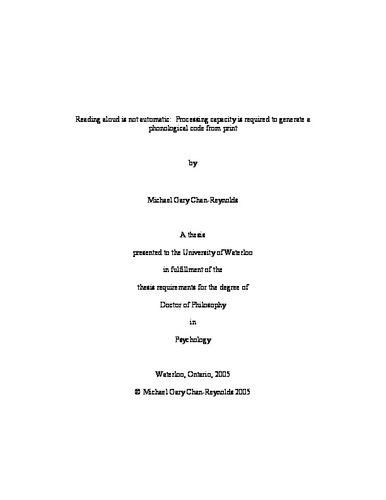| dc.contributor.author | Chan-Reynolds, Michael G. | en |
| dc.date.accessioned | 2006-08-22 13:41:58 (GMT) | |
| dc.date.available | 2006-08-22 13:41:58 (GMT) | |
| dc.date.issued | 2005 | en |
| dc.date.submitted | 2005 | en |
| dc.identifier.uri | http://hdl.handle.net/10012/753 | |
| dc.description.abstract | The process of generating a phonological code from print is widely described as automatic. This claim is tested in Chapter 1 by assessing whether phonological recoding uses central attention in the context of the Psychological Refractory Period (PRP) paradigm. Task 1 was a tone discrimination task and Task 2 was reading aloud. Nonword letter length and grapheme-phoneme complexity yielded additive effects with SOA in Experiments 1 and 2 suggesting that <em>assembled phonology</em> uses central attention. Neighborhood density (N) yielded additive effects with SOA in Experiments 3 and 4, suggesting that one form of lexical contribution to phonological recoding also uses central attention. Taken together, the results of these experiments are <em>inconsistent</em> with the widespread claim that phonological codes are computed automatically. Chapter 2 begins by reconsidering the utility of ?automaticity? as an explanatory framework. It is argued that automaticity should be replaced by accounts that make more specific claims about how processing unfolds. Experiment 5 yielded underadditivity of long-lag word repetition priming with decreasing SOA, suggesting that an early component of the lexical contribution to phonology does not use central attention. There was no evidence of Task 1 slowing with decreasing SOA in Experiments 6 and 7, suggesting that phonological recoding processes are postponed until central attention becomes available. Theoretical development in this field (and others) will be facilitated by abandoning the idea that skilled performance inevitably means that all the underlying processes are automatic. | en |
| dc.format | application/pdf | en |
| dc.format.extent | 507157 bytes | |
| dc.format.mimetype | application/pdf | |
| dc.language.iso | en | en |
| dc.publisher | University of Waterloo | en |
| dc.rights | Copyright: 2005,
Chan-Reynolds, Michael G.. All rights reserved. | en |
| dc.subject | Psychology | en |
| dc.subject | visual word recognition | en |
| dc.subject | reading aloud | en |
| dc.subject | nonword | en |
| dc.subject | attention | en |
| dc.subject | dual task | en |
| dc.title | Reading aloud is not automatic: Processing capacity is required to generate a phonological code from print | en |
| dc.type | Doctoral Thesis | en |
| dc.pending | false | en |
| uws-etd.degree.department | Psychology | en |
| uws-etd.degree | Doctor of Philosophy | en |
| uws.typeOfResource | Text | en |
| uws.peerReviewStatus | Unreviewed | en |
| uws.scholarLevel | Graduate | en |

